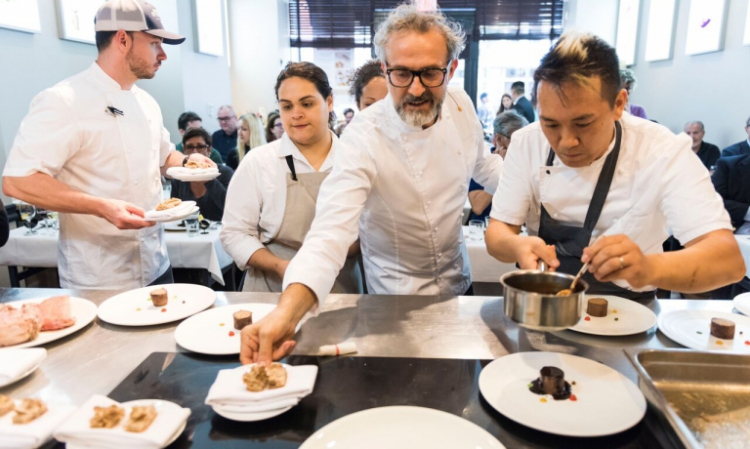There’s a strong connection between Italian and Japanese cuisine according to Massimo Bottura. It’s not the result of an exchange, an interaction or a cultural similarity: it’s an affinity made by history in melting pots that are 9700 km apart. As a consequence, they have never communicated, but developed their own features by ignoring each other over the centuries. Until they reached comparable results.
The chef from Modena explains: «What are the greatest culinary traditions of the world? I’d say the French, Chinese, Japanese and Italian». Then he puts them in pairs: «The former two focus on technique, on transforming products in the kitchen. The latter two – our own and Japanese cuisine – developed a different mentality and approach: we are both obsessed with ingredients. Of course there’s technique as well: but it’s always considered at the service of raw materials. In a way, the chef is always in the background».

Bottura with one of his sous chefs, JapaneseTakaiko Kondo
There’s a bridge, points out
Bottura. A fertile connection proven, for instance, by the many Japanese who work in the most important Italian brigades, including
Takahiko Kondo, sous chef at
Osteria Francescana. And it’s no coincidence that the person who used to have the same role before him, that is to say
Yoji Tokuyoshi, now tries the complex and ambitious task of interpreting Italian traditions with his oriental background, in Milan. In other ways, he tries to find a Japanese interpretation to our cuisine, relying on the above mentioned common features, and then playing on their differences.
So given this is a stimulating topic, of course Bottura had to analyse it too. He mentioned this recently, during the presentation of Al Mèni’s programme, in Milan (see: Bottura ci spiega 5 buoni motivi per non mancare ad Al Mèni): «I studied a new, fantastic dish», he said. It’s called Wagyu non wagyu and it’s the opposite of a Japanese take on an Italian dish, it’s an Italian take on a Japanese dish
It’s been recently introduced in the menu, «it’s suitable for the spring and summer months, and must be served lukewarm, as a pre-dessert». It’s made of pork belly and pork heart, with ponzu sauce (made with mirin, rice vinegar, flakes of katsuobushi and konbu seaweed, simmered. When the liquid is cold, they strain it to dry the katsuobushi, adding yuzu or sudachi juice).
Bottura adds: «We use pork belly and heart, that is to say a fat part and a red part, rich in iron. We alternate them to create a millefoglie, one layer after the other, after marinating them in salt and sugar [giving the sweet component that suits a pre-dessert]. We then seal them in a vacuum pack».
Fifteen days later, this Wagyu non wagyu is served with some lukewarm broth made with burnt onion and aromatised with citrus fruits. «It seems shabu shabu, in fact it’s just pork heart with onion!», jokes the chef from Modena. Italian simplicity: but the focus on ingredients is such that it creates the perfect assonance with a Japanese excellence.
Translated into English by Slawka G. Scarso